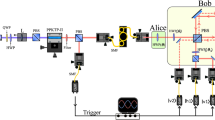Abstract
Linearly independent pure quantum states can be discriminated unambiguously, while linearly dependent states cannot. We use a physical accessible unitary transformation to map the nonorthogonal quantum states onto a set of orthogonal ones so that measuring the output states can discriminate the initial states with the deterministic and inconclusive results. The failure states that give an inconclusive result are linearly dependent ones. In finding the optimal unambiguous discrimination (UD), we show that a main constraint condition that the determinant constructed by the complex inner products of the failure states must be zero, along with two additional conditions, can provide solutions to the problem of the optimal UD for pure qudits. For any d, we give one analytical solution as all the Berry phases being zero. We also derive the lowest bound of the total failure probability of the optimal UD.
Similar content being viewed by others
References
Gisin, N., Ribordy, G., Tittel, W., et al.: Quantum cryptography. Rev. Mod. Phys. 74, 145 (2002)
Scarani, V., Bechmann-Pasquinucci, H., Cerf, N., et al.: The security of practical quantum key distribution. Rev. Mod. Phys. 81, 1301 (2009)
Barnett, S.M., Croke, S.: Quantum state discrimination. Adv. Opt. Photon. 1, 238 (2009)
Bergou, J.A.: Discrimination of quantum states J. Mod. Opt. 57, 160 (2010)
Chefles, A.: Unambiguous discrimination between linearly independent quantum states. Phys. Lett. A 239, 339 (1998)
Ivanovic, I.D.: How to differentiate between non-orthogonal states. Phys. Lett. A 123, 257 (1987)
Dieks, D.: Overlap and distinguishability of quantum states. Phys. Lett. A 126, 303 (1988)
Peres, A.: How to differentiate between non-orthogonal states. Phys. Lett. A 128, 19 (1988)
Jaeger, G., Shimony, A.: Optimal distinction between two non-orthogonal quantum states. Phys. Lett. A 197, 83 (1995)
Terno, D.R.: Optimal distinction between non-orthogonal quantum states. J. Phys. A 31, 7105 (1998)
Clarke, R.B.M., Chefles, A., Barnett, S.M., et al.: Experimental demonstration of optimal unambiguous state discrimination. Phys. Rev. A 63, 040305(R) (2001)
Sun, Y., Hillery, M., Bergou, J.A.: Optimum unambiguous discrimination between linearly independent nonorthogonal quantum states and its optical realization. Phys. Rev. A 64, 022311 (2001)
Jafarizadeh, M.A., Rezaei, M., Karimi, N., et al.: Optimal unambiguous discrimination of quantum states. Phys. Rev. A 77, 042314 (2008)
Herzog, U., Bergou, J.A.: Optimum unambiguous identification of d unknown pure qudit states. Phys. Rev. A 78, 032320 (2008)
Pang, S., Wu, S.: Optimum unambiguous discrimination of linearly independent pure states. Phys. Rev. A 80, 052320 (2009)
Sugimoto, H., Hashimoto, T., Horibe, M., et al.: Complete solution for unambiguous discrimination of three pure states with real inner products. Phys. Rev. A 82, 032338 (2010)
Bergou, J.A., Futschik, U., Feldman, E.: Optimal unambiguous discrimination of pure quantum states. Phys. Rev. Lett. 108, 250502 (2012)
Zhou, X.-F., Lin, Q., Zhang, Y.-S., et al.: Physical accessible transformations on a finite number of quantum states. Phys. Rev. A 75, 012321 (2007)
Zhou, X.-F., Zhang, Y.-S., Guo, G.-C.: Unambiguous discrimination of mixed states: a description based on system–ancilla coupling. Phys. Rev. A 75, 052314 (2007)
Chen, P.-X., Bergou, J.A., Zhu, S.-Y., et al.: Ancilla dimensions needed to carry out positive-operator-valued measurement. Phys. Rev. A 76, 060303 (R) (2007)
Acknowledgments
This research was funded by the National Science Foundation of China under Grants No. 11074002, No. 61073048, and No. 11104057, and the Natural Science Foundation of the Education Department of Anhui Province of China under Grants No. KJ2010ZD08 and No. KJ2012A245, and the Postgraduate Program of Huainan Normal University.
Author information
Authors and Affiliations
Corresponding author
Rights and permissions
About this article
Cite this article
Zhang, WH., Yu, LB., Cao, ZL. et al. Optimal unambiguous discrimination of pure qudits. Quantum Inf Process 13, 503–511 (2014). https://doi.org/10.1007/s11128-013-0666-x
Received:
Accepted:
Published:
Issue Date:
DOI: https://doi.org/10.1007/s11128-013-0666-x



